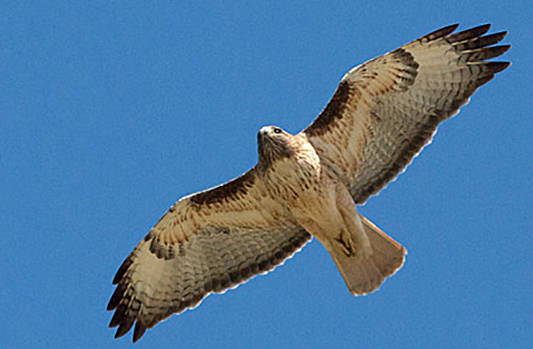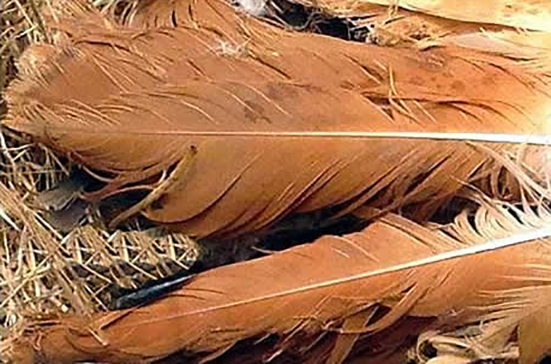Red-Tailed Hawk
Buteo jamaicensis

Red-tailed Hawk with moon over Estero Bay CA
By Mike Baird from Morro Bay, USA https://commons.wikimedia.org/w/index.php?curid=32354021
The red-tail is one of the the largest hawks, usually weighing between two and four pounds. As with most raptors, the female is nearly a third larger than the male and may have a wing span of 56 inches. This species shows a great deal of individual variation in plumage.
The adult has a rufous-colored tail that may or may not have a black terminal bar. Adults are dark brown on the back and the top of their wings. The underside of the bird is usually light with a dark belly band, and a cinnamon wash on the neck and chest. Immature hawks resemble the adults except their tail is brown with dark bars; the red-tail molts in during its second year.

The adult red-tailed hawk is easily identified, for when it leaves its perch on slow, measured wing beats, or turns while soaring overhead, the broad, rounded tail shows a rich, russet red, hence the name. Within its range, its frequent soaring and loud voice are a good pointer.

Geography – Range
The red-tailed hawk ranges throughout North America to central Alaska and northern Canada, and south as far as the mountains of Panama. Although not truly migratory, they do adjust seasonally to areas with the most abundant prey. In winter many of the northern birds move south.
| Red-Tailed Hawk Buteo jamaicensis Phylum: Chordata Class: Aves Order: Falconiform Family: Accipitridae Genus: Buteo Species: jamaicensis |
Vital Stats Weight: 2-4 lbs. Length: 22" Wing Span: 56 inches" Sexual Maturity: 3 yrs. Mating Season: spring Incubation: 28-32 days No. of Eggs: 1-3 Birth Interval: year Lifespan: 10-21 yrs. Typical diet: small rodents, snakes |
Related Species
Hawks are carnivores (meat eaters) that belong to the category of birds known as raptors -- birds of prey. They have strong, hooked beaks; their feet have three toes pointed forward and one turned back; and their claws, or talons, are long, curved and very sharp. Prey is killed with the long talons and, if it is too large to swallow whole, it is torn into bite-sized pieces.
Since the beginning of recorded history, birds of prey have been both despised and revered. The sport of falconry -- using raptors as hunting aids -- has been practiced in Asia and Egypt since 3000 BC. Yet, until recent years, birds of prey have also been ruthlessly destroyed because of real or imagined competition with humans for game and domesticated animals.
The red-tailed hawk is a grouping of 14 sub-species, each of which is more or less specific to a geographical area, and differs from the others in size, markings etc.
Comparisons
Based on general body shape and flight habits, hawks are classified into different groups (genera): the most common being the Accipiters and the Buteos.
The sharp-shinned hawk, the Cooper's hawk and the goshawk are Accipiters. They have long tails and short, rounded wings that enable them to dart through and around trees in pursuit of other birds, their principal prey. Typically, they fly low with a series of rapid wing beats followed by a brief period of sailing, then another series of wing beats. Accipiters are associated with brush and timbered areas.
The Buteos are the largest of the hawks. They are the broad-winged, broad-tailed soaring hawks that are more readily seen because of their habit of circling high in the air or perching in dead trees or on telephone poles along the road. They include the red-tailed, the red-shouldered, the Swainson's, the rough-legged and the ferruginous hawks.
Vocalization
The red-tailed hawk has a hoarse and rasping 2- to 3-second scream that is most commonly heard while soaring. They are loudest when defending their young. When parents leave the nest, the young utter a loud wailing "klee-uk," repeated several times - this is a food cry.
Tail
The red-tailed hawk has a broad, rounded tail that shows a rich, russet red.

Eyes
The eyesight of a hawk is eight times as powerful as a human's.

Behavior
The red-tailed hawk is the most widespread and familiar member of the American Buteos (large soaring hawks). They nest in the month of March in tall trees. Like all other Buteos, they do not fly fast but soar at high altitudes using their keen eyesight to spot the slightest movement in the grass below. It is an aggressive bird and vigorously defends its territory, especially during the winter months when hunting is difficult.
Habitat
The red-tailed hawk is usually found in grasslands or marsh-shrub habitats, but is a very adaptable bird, being equally at home in deserts and forests, and at varying heights above sea level.
Food & Hunting
The red-tailed hawk is a most opportunistic hunter. Its diet is varied, but there is conclusive evidence now that 85 to 90% is composed of small rodents, with rabbits, snakes and lizards included. Where there are large numbers of pheasant, these become the food of choice in spring and summer. Like all hawks, its talons are its main weapons.
Curious Facts
Hawks are carnivores (meat eaters) who belong to the category of birds known as raptors.
The red-tailed hawk is the most common member of the buzzard hawk family.
The eyesight of a hawk is 8 times as powerful as a human's.
Like all hawks, the red-tailed hawk's talons are its main weapons.
The red-tailed hawk has a hoarse and rasping 2- to3-second scream that is most commonly heard while soaring.
85 to 90% of the red-tailed hawk's diet is composed of small rodents.
Related DesertUSA Pages
- How to Turn Your Smartphone into a Survival Tool
- 26 Tips for Surviving in the Desert
- Your GPS Navigation Systems
May Get You Killed
- 7 Smartphone Apps to Improve Your Camping Experience
- Desert Survival Skills
- Successful Search & Rescue Missions with Happy Endings
- How to Keep Ice Cold in the Desert
- Desert
Survival Tips for Horse and Rider
- Preparing
an Emergency Survival Kit
Share this page on Facebook:
The Desert Environment
The North American Deserts
Desert Geological Terms




